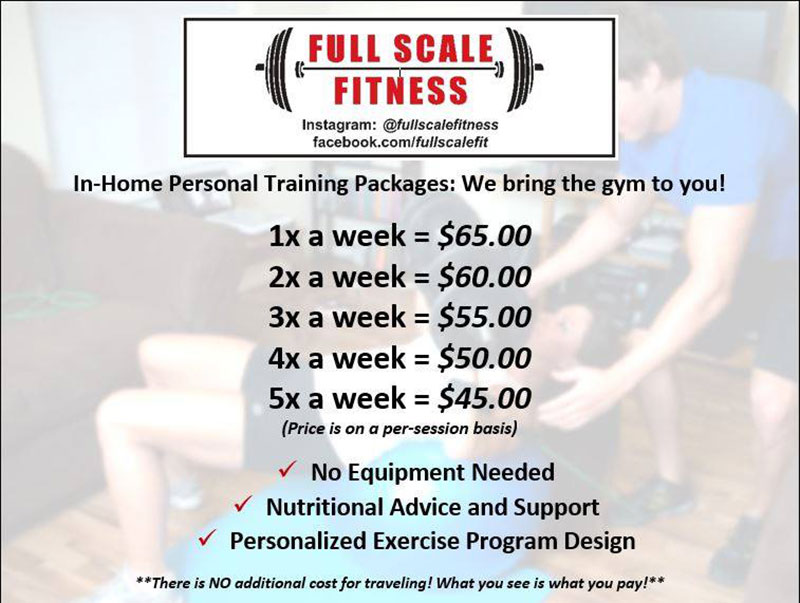For a few decades now, more and more people have considered personal training as a viable career choice. With the world's shift toward the online realm, many are looking for an online coach. So, how to start an online personal training business and make it a successful endeavor?
Even for established personal trainers, moving into the online training business is a smart decision. Although the main difference is working with clients remotely, this form of personal training still allows you to make a significant impact on people's health.
Many choose this path due to the no-income limit and even more flexible working hours. But with all these benefits, the market is expanding fast, and competition is tough to beat.
While this venture may seem daunting now, it all comes down to a few key principles that have worked well for many startups.
What is Online Personal Training?

Online personal training is a type of fitness coaching done remotely through digital platforms, over the internet. It can be done in real-time or pre-recorded so clients follow a video while working out at home.
The aim of this training is also to improve body image, fitness levels, health, and performance. This is done through individual training and meal plans that clients should follow.
Online coaching is a diverse group of personal training and includes:
- Hybrid online and in-person approach
- Non-personalized PDF fitness programs
- Non-personalized video fitness programs
- Online group personal training
- Private personalized online training
Steps Before Starting Your Online Personal Training Business
1. Get a proper certification

With the whole internet as a market, there are plenty of opportunities. Still, the online training business is very competitive.
Given the abundance of qualified trainers available, clients are unlikely to choose someone who isn’t qualified. Having some kind of personal trainer certification helps to build trust and credibility. Be sure to take care of this before you even start working.
2. Gain relevant experience
After you get certified, the next step is finding a job. Many trainers decide to first start working at some local gym before opening their own business. Consider this a stepping stone to gaining your clientele and learning how everything actually works. Experience is a great advantage when entering the online personal training business. It also helps build a good reputation.
Before jumping into online personal training, try hybrid personal training. This model combines in-person and online sessions. Transition isn’t always easy, and this is a good way to test the waters.
3. Learn to set proper goals

Making a good plan starts with defining the objective. The same is true when it comes to making plans in your personal training business. When working with clients at the gym, see how good you are at setting the right goals and creating proper plans. This will be crucial for successfully running your business down the line.
In this scenario, the client knows what they should do and is less likely to cancel sessions. By not defining a goal, the training loses value and the client loses interest. And without proper client retention strategies, your business will be doomed.
A training objective must be specific in its outcome and timeframe. The exact objective depends on the client's wishes and your skills as a trainer.
Some examples include:
- Lose [X] pounds in [X] weeks
- Gain [X] pounds of muscle in [X] weeks
- Increase 1rm by [X] percent in [X] weeks
- Improve 5k run time by [X] minutes in [X] weeks
4. Discover your ideal clients
While working in the gym, you don’t get to choose who you are going to train, but when starting an online personal training business, all these decisions will be on you. Picking a niche, a specific part of the market to focus on is important. This will present you as a market leader in a certain kind of training. Many people will automatically come to a trainer who offers them something unique.
Before opening, do some market research. Find out why people prefer an online trainer to a personal trainer at a gym. Think about the kind of people who would be most interested in remote training. Then, adjust any advertising to speak to that demographic.
When choosing your niche, consider who you are looking to work with tomorrow:
- Professional athletes
- Elderly
- Youths
- Celebrities
- People interested in losing weight
- People looking to gain weight and muscle mass
In the beginning, the best strategy is not to be too picky with the clients. But with more skill and experience you gain, feel free to be more selective with the clientele you want to work with.
How to Financially Benefit from Online Personal Training
Avoid paying gym rent
If you only offer online classes, there is really no need for you to have your own gym space. Renting one is a huge financial burden and no one is actually going to use it.
Invest in a few pieces of equipment like dumbbells, exercise bands, yoga mats, and pilates balls. These are likely the only tools clients will also have at home, so you need to adapt your workouts accordingly.
Work with more clients

An online personal training business allows the trainer to get more clients. So, as you are not limited by gym working hours or need time for commuting, you can better optimize your schedule.
Additionally, consider pre-recording a few sessions and offering them as an online program clients can follow on their own. An embedded PDF viewer within your online program can provide clients with easy access to supplementary materials or guides.
This will free up more of your time while also generating a good income.
How to Start an Online Personal Training Business: Step-by-Step Guide
Step 1: Choose the right business model
Business ownership is a big responsibility; with everything you need to decide on, it’s easy to let a few big decisions slip. In order to help you stay on top of business launch, let’s outline some choices you’ll need to make:
- What kind of services will you offer? Will you focus on making personalized workout plans, doing nutritional coaching, or offering live training sessions? You don’t have to choose only one, but be sure to define what your primary focus is.
- Define your target audience and niche. Will you specialize in weight loss coaching, strength training, sports-specific conditioning, or something else?
- Establish a business model. Will you be offering individual sessions, semi-private, or group workouts?
- Decide on your pricing structure. You can offer monthly subscriptions, one-time fees, package deals, etc.
- Select the digital tools and technology you'll use to deliver your services effectively.
Set up a pricing structure

As we have already mentioned the importance of finding your audience and setting up your services, now we will dive deeper into pricing systems you can implement.
The final price you will charge will greatly depend on factors such as location, experience, specialization and the exact service the client chose. If you need help in this department, here is the text explaining how much to charge for personal training. But, here, we will cover the different structures, no matter the amount.
First of all, you can have a flat hourly rate you charge for a training session. Second, you can offer different package deals where a client can purchase a certain number of sessions with a small discount. The more sessions they choose, the better the discount they should get. This model encourages commitment and you will be paid upfront.
The next model is a monthly subscription. Here, you’ll charge the client a fixed fee for a set number of sessions that can be used in a single month. Variations of this model are quarterly and yearly memberships, which should allow the client to save the most money if they actually decide to commit to it.
Lastly, you can sell memberships for the duration of a certain online program you offer. The price can vary depending on the complexity and the number of workouts it includes. This is a great pricing option if you plan on selling a lot of pre-recorded workout programs.
Flexibility in pricing and having different options can help attract a wider range of clients so don’t get stuck on offering only one model.
Create packages for different types of clients
Creating packages is a great way to make your job easier while still providing top-notch service to each and every client. Some think that templated workouts are no good or are not really beneficial for the client. Templated workouts can, in fact, be very useful if used in the right way.
Often, clients fall into a specific category. A 40-year-old man who wants to lose belly fat will follow a regime similar to a person with the same objective.
So, having a template can be very beneficial. Even when using a template, the exact workout can be tweaked to fit the specific person.
Present the package in a way that a client can understand its benefits. Here are some ways of showcasing them the right way:
- Some lines on who it is designed for.
- Some lines on the expected results.
- A list of service features. Include how each feature benefits a client. For example, “WhatsApp support to keep the program on track.”
- The price and duration. For example, $1,200 for 12 weeks.
- If applicable, break the price down into a payment plan. For example, $400 per month.
- Add a call to action. This tells the client what the next step is.
Get familiar with technology

For an online personal trainer, having the right technology and knowing how to use it is a must. To start with, there are two things needed. The first one is a camera.
This could be the camera of a laptop, a tablet, or a smartphone. You don’t have to have some expensive fancy equipment, especially in the beginning. The purpose of the camera is that you can demonstrate the exercise, and be sure your client has his on as well, so you can see their form.
And if you are creating an online program clients will follow on their own, record videos to demonstrate the exercises while simultaneously explaining what to do.
Basically, it is the same as showing an exercise live in a gym, but instead of doing it in front of people, it is done in front of a camera. Here are some basic tips for making a good video:
- Do not use music.
- Have adequate lighting.
- Use at least two full repetitions.
- The ideal length of one video is 10 to 20 seconds. These are demonstrations, not tutorials.
Make sure you are providing a clear visual demonstration and feel free to include voice-over if the exercise is more complex.
Choose a good location for a session
Another important factor to consider is the space where the sessions are held. The following questions serve as a guide in selecting the appropriate area:
- Does it have enough space to demonstrate the exercises?
- Does it have enough space for all the equipment?
- Is the presentation professional, and is the space clean and free from distractions? The kitchen is probably not the best place, nor is it a place where people walk around a lot.
- Does it have good lighting at any time of the day? The best is natural light, but artificial light can work too.
Do not put the camera too close so the complete routine is visible to the client. Lastly, all necessary equipment should be on the side but within reach so you do not waste time fetching and searching for props.
Step 2: Secure your business
Every business needs insurance and getting the right one for your venture is crucial so you avoid any liability in the future. Look at it this way, the insurance is there to protect both you and your client in case of any accidents so having a few policies can’t hurt.
- Professional Liability insurance. This insurance policy protects personal trainers against claims of negligence or professional mistakes. It covers legal costs, settlements, or judgments if a client files a claim that a trainer’s advice or service has caused an injury or financial loss.
- Product Liability insurance. Great choice if you plan on selling any products. In case you are selling supplements or equipment, this insurance protects against claims related to defects or injuries caused by those products.
- Property insurance: This covers physical assets such as fitness equipment, gym space, or studio contents against damage or loss due to fire, theft, or other covered perils.
These are just some of the insurance policies fitness trainers can get. Be sure to speak to a professional and review policy details carefully. In the end, you should choose an insurance plan tailored to the specific risks faced in the fitness industry.
Step 3: Establish your online presence
Considering the fact that you plan on being an online personal trainer, having a prior online presence is essential. This includes creating social media profiles and building a professional website. These channels will be perfect places for sharing your services, highlighting your qualifications and posting client testimonials.
Set up a website
A website enables the business to obtain an online home, a domain. Having a personal domain is important as it shows your professionalism. Your website serves as a central hub where potential clients can learn about your services and easily book the one they need. Ensure your website is user-friendly and visually appealing.
It’s not only about creating a website; it's about establishing a brand. Give it a proper name, come up with a logo, and define your mission. The name and branding should make it clear that this is an online personal training business.
Most prospective clients will first look for a website before contacting a trainer. So, the website will speak before a trainer can personally convince someone.
Make sure the website features some of the following:
- Reviews and testimonials.
- Before and after photos of satisfied customers, of course, with their consent.
- Details of experience, previous jobs, education, and certifications.
- Blog articles that show perspective on training topics.
- Workout templates, nutrition guides, recipes, etc.
Grab clients' attention with the perfect booking website
The importance of a professional website is undeniable, but what if you don’t know how to create one? Hiring a professional may be a great option, but it is surely a pricey one.
Trafft is free fitness scheduling software created for personal trainers who want to elevate their business to a whole new level while also boosting their revenue.
With Trafft, you can create your booking website in just a few clicks and you don’t need any particular skill set to do so. A variety of themes you can choose from will ensure your booking page reflects your brand and meets your specific needs. You can even create a custom domain so it fits your brand and guarantees people remember your business.
Whether you're offering individual training sessions, group classes, or online programs, Trafft is a perfect tool for managing all your bookings. Additionally, Trafft lets you send email and SMS reminders just to make sure your clients show up, every time!
Want to know more? Check out Trafft’s awesome features to see what you’ve been missing. Or even better, head to Trafft’s sign-up page and see why so many personal trainers can’t live without it!
Step 4: Market your services
Now that you’ve started making your online presence, it’s time to also promote your business so clients start rolling in. And, as you already know what audience you want to reach, let’s cover different marketing channels you can utilize.
Email marketing
Your website will generate leads over time, but so can your email. From time to time, you can implement an email outreach campaign to find new leads. For this endeavor, it’s usually best to engage a marketing specialist from a digital marketing agency for startups. On the other hand, there are marketing courses available that focus on the use of email. However, conducting an email marketing campaign is very time-consuming.
PPC Advertisement: Facebook and Google
It is an open secret that ads on Facebook and Google are the most powerful strategies in marketing. Using them will make sure thousands of people become familiar with your business. To do this effectively, identify the best keywords and be sure to specify your target audience. This simple strategy can also boost website hits.
Influencer marketing
Fitness influencers reach an incredible number of people, all potential clients. Through them, prospective customers can find out how to get the results they are after. Influencer identification and partnership management is not easy but it involves mutual benefits.
Be sure to reach out to influencers that fit your brand's image and work with them to execute effective campaigns. Nonetheless, be prepared to pay a large sum for their posts.
Content marketing

Sometimes it's hard to keep clients coming back to your website. So, the right content is essential in generating leads and forming a loyal customer base. If you are good at writing, start a blog where you will answer some of the questions about fitness. These posts can also be used for different ads so they generate more traffic on your website.
In order for your efforts to be successful, aim to post new content every few days and create a content calendar so you keep track of everything.
Social media
Social media is one of the best ways to market online personal training businesses. After determining the name and brand identity, post frequently on all the platforms you decide to use.
But be sure to also engage with other users. Respond to their posts, answer messages you get, and constantly highlight the benefits of your workout programs. Some popular platforms you can leverage include:
- Quora
- TikTok
- YouTube
Don’t limit yourself to only one platform. Depending on the audience you are trying to reach, sign up for the different ones they use the most.
Podcasts

In the last few years, podcasts are getting more and more popular. These audio recordings provide listeners with a convenient way to consume content on the go. Podcasts cater to large clientele as well; as many prefer to listen as opposed to read about something they are interested in. As a result, many new clients will find their way to your online personal training business through this channel.
Record a personal podcast or find other podcasts in which to participate. Many of the podcast hosts are always on the lookout for guest speakers as it helps them reach different audiences as well.
Step 5: Build client relationships
If you followed all the previous steps, you have probably launched a successful online personal training business by now. But to ensure things stay this way and to grow your business even further, it's necessary to take time to build strong client relationships. You may be wondering why this is so important. After all, isn’t it better to focus all your efforts on gaining new clientele?
Well, as it turns out, acquiring a new customer can cost five times more than retaining an existing one. Your best shot at keeping a stable income is investing in the satisfaction of your current customers while working on growing this number.
Communication is key; regularly check in with your clients to understand their progress, challenges, and goals. Provide feedback and encouragement to keep them motivated and engaged. They need to feel you are there for them and know they are heard. Various communication channels such as email, social media, or messaging platforms can help you achieve consistency.
Lastly, show genuine interest in their fitness journey and listen attentively to their feedback. By building trust and a connection, you'll not only enhance client satisfaction but also increase retention rates. Remember, happy clients are your best ambassadors in the competitive online fitness industry.
Step 6: Monitor your strategy
After you have all the desired strategies in place, monitoring how they perform can help you stay on track to success. Regularly analyze key performance indicators (KPIs) such as client acquisition costs, conversion rates, and retention rates. Evaluate the effectiveness of your marketing campaigns, social media efforts, and client engagement strategies.
Based on this data, identify trends, strengths, and areas for improvement and adjust your approach if needed. Regularly check industry trends and evolving client preferences. By continuously monitoring and adapting your strategy, you'll position your business for long-term success in the dynamic online fitness industry.
If you need help further developing your knowledge, sales training software can help you gain efficient sales skills, which will definitely come in handy.
Ending Thoughts on How to Start an Online Personal Training Business
Becoming an online personal trainer takes commitment and determination as the industry is rapidly growing. You, as a new trainer, need to stand out from the rest. But, don’t forget to acquire all the necessary knowledge beforehand so people see you as an expert from the start.
Take time to build a solid client base, give them excellent service, and get referrals from them. Make good use of technology and automate as many parts of the process as desired.
Client satisfaction is the single most important factor in building a successful business. So, create programs that help clients reach their fitness goals.
If you enjoyed reading this article and want to know more, here’s how to get clients for your online personal training business. Additionally, here is the article to help you determine how much you should charge for online personal training.
FAQs About Starting an Online Personal Training Business
1. What kind of certification or training is required to become an online personal trainer?
If you want to become a personal trainer, you need to pass a certification exam. Many different certification programs can be completed online. Just select the one accredited by the National Commission for Certifying Agencies (NCCA) and purchase all the materials needed for the testing.
2. What equipment or tools do I need to start an online personal training business?
Depending on your particular workouts, different equipment and resources may be required to launch an online personal training business. Yet a computer or mobile device, video conferencing software, and a steady internet connection are, at the very least, required. Resistance bands, dumbbells, and fitness trackers could be additional helpful equipment.
3. How can I create a website or a social media account to promote my online personal training services?
If you don’t have any coding experience, you can create a professional-looking website through website builders like Wix or Squarespace. Social media channels such as Instagram, Facebook, and TikTok can be utilized to promote customer success stories, offer tips and guidance, and communicate with future clients.
4. How do I set prices for my online personal training services, and what payment methods should I accept?
The cost of online personal training services might vary depending on your education, experience, and the services provided. Researching competitors' prices is crucial to ensure reasonable rates. Credit cards, PayPal, and Venmo are frequently accepted payment options.
5. How can I differentiate myself from other online personal trainers and stand out in the market?
Offering unique services, focusing on a certain niche, or being an expert in the field are some ways to set yourself apart from other online personal trainers.
6. What legal requirements do I need to fulfill to start an online personal training business?
Depending on the state or country you operate from, there may be different legal requirements for launching an online personal training operation. Two frequent prerequisites are acquiring liability insurance and registering the firm with the relevant federal, state, and local agencies.
7. How do I develop personalized training plans for my online clients and assess their progress remotely?
Understanding the fitness goals, common challenges, and preferences the client has is essential for creating a tailored training regime. Trainerize and MyFitnessPal are just two examples of the numerous programs and applications that can be used to make customized regimens and monitor progress.
8. How can I effectively market my online personal training services to potential clients?
There are many ways to market an online personal training business, including paid advertising, social media promotion, and referral bonuses. Free trials or consultations can also help you turn prospective clients into paying customers.
9. How do I handle client communication and online support?
It is essential to forge a relationship of trust with clients and ensure their success through effective communication and assistance. Virtual check-ins and addressing client problems can be accomplished with the help of email and videoconferencing technologies. Building a solid client-trainer relationship also requires prompt responses and transparent communication.
10. How can I expand my online personal training business and increase revenue over time?
Offering more services, like virtual group fitness classes or nutrition advice, might help grow an online personal training business. Collaboration with other companies or fitness experts can aid in expanding visibility and bringing in new customers. Over time, higher revenue might result from developing a solid internet presence and customer base.







